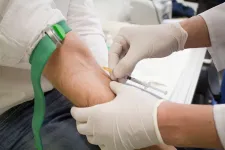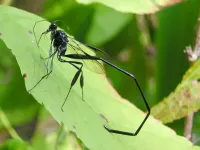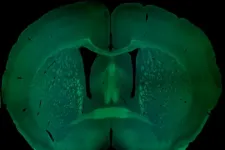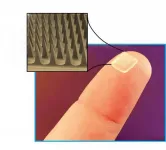Tübingen study raises hope for effective malaria vaccine
2021-05-05
(Press-News.org) Sanaria® PfSPZ-CVac" is a live vaccine consisting of infectious Plasmodium falciparum (Pf) malaria parasites that are injected into the subject at the same time as they receive an antimalarial drug. The parasites quickly enter the liver where they develop and multiply for 6 days, and then emerge into the blood As soon as the parasites leave the liver, the drug kills them immediately. Thus, the immune system of the vaccinated subject is primed against many parasite proteins and becomes highly effective at killing malaria parasites in the liver to block infection and prevent disease.
"With this study, we have reached a new important milestone in the development of an effective malaria vaccine. With only three immunizations over four weeks, we achieved very good protection against malaria," explains Prof. Peter Kremsner, who has helped to advance the malaria research field at the DZIF since its inception. His team was able to develop a new immunization regimen that significantly reduces vaccine administration compared to previous studies. The number of visits required by a subject for complete immunization has been reduced from 13 to three. Importantly, the team showed that vaccination with parasites from Africa could protect against genetically diverse parasites from South America.
Proof of efficacy was provided using the controlled human malaria infection (challenge) regimen developed by the Tübingen and Sanaria teams. Here, the test subjects were infected with parasites after immunization. If immunization against the parasites was successful, the parasites would be specifically killed by the immune system. If the immune protection is incomplete and the parasites multiply, the test subjects are treated before any symptoms of disease appear. Ten of 13 subjects vaccinated in this study were completely immune to the infection.
"The vaccine produces a high level of different antibodies and immune cells in the body that can recognize both the injected parasites and antigens of the subsequent liver stage. These antibodies and immune cells contribute to the strong protective immunity" explains Dr. Rolf Fendel.
With an estimated 229 million infections and 409,000 deaths worldwide in 2019, malaria is one of the world's most important and dangerous infectious diseases. It is caused by parasites transmitted to humans through the bites of infected female mosquitoes. Children under the age of five are the most vulnerable group affected by malaria, accounting for 67 percent (274,000) of all malaria deaths worldwide in 2019.
INFORMATION:
About Sanaria Inc.
Sanaria is a biotechnology company based in Rockville, Maryland (USA) that is developing whole parasite PfSPZ vaccines to protect against malaria in collaboration with the University Hospital of Tübingen, Germany. Sanaria's vaccines have been shown to be highly protective against Plasmodium falciparum infections in humans. Sanaria's vaccines will be used to prevent malaria in individuals and in combination with other malaria control measures to stop malaria transmission and eliminate malaria.
About the DZIF
The German Center for Infection Research (DZIF) coordinates translational infection research in Germany and provides strategic direction. Its mission is to translate results from basic infectious disease research into clinical research and bring them to patients. 35 DZIF research institutions work together against the global threat of infectious diseases. The Tübingen site coordinates the research area Malaria with site spokesperson Prof. Peter Kremsner, and co-coordinators are active at the site for Gastrointestinal Infections, Hospital Germs and Antibiotic-Resistant Bacteria and New Antibiotics.
[Attachments] See images for this press release:

ELSE PRESS RELEASES FROM THIS DATE:
2021-05-05
Daniel Redhead, from the Max Planck Institute for Evolutionary Anthropology, and Chris von Rueden, from the University of Richmond, published a new study that describes coalition formation among men in Tsimané Amerindians living in Amazonian Bolivia, over a period of eight years. In two Tsimané communities, the authors describe the inter-personal conflicts that tend to arise between men, and the individual attributes and existing relationships that predict the coalitional support men receive in the event of conflicts.
Conflicts that arise between men concern disputes over access to forest for slash-and-burn horticulture, as well as accusations of theft, laziness, negligence, ...
2021-05-05
In about a quarter of patients with hereditary diseases, the cause of the disease remains unclear even after extensive genetic testing. One reason is that we still do not know enough about the function of many genes. Of the 30,000 known genes, just a little more than 4,000 have been found to be associated with hereditary diseases.
At the Department of Clinical Genetics of the University of Tartu Institute of Clinical Medicine, under the leadership of Professor Katrin Õunap, patients with hereditary diseases of unclear cause have been studied in various research projects since 2016. In collaboration with the Broad Institute of MIT and Harvard, these patients have undergone extensive genome-wide sequencing analyses at the level of the exome (the sequence of all genes), ...
2021-05-05
Knowing what species live in which parts of the world is critical to many fields of study, such as conservation biology and environmental monitoring. This is also how we can identify present or potential invasive and non-native pest species. Furthermore, summarizing what species are known to inhabit a given area is essential for the discovery of new species that have not yet been known to science.
For less well-studied groups and regions, distributional species checklists are often not available. Therefore, a series of such checklists is being published in the open-access, peer-reviewed Journal of Hymenoptera Research, in order ...
2021-05-05
5 May 2021, Bristol - In one of the most advanced applications of in-vitro 3D human lung models in vape research to date, a new peer-reviewed Imperial Brands study shows that, unlike combustible cigarette smoke, blu aerosol had little to no impact on numerous toxicological endpoints under the conditions of test using laboratory models.
Published in the journal Current Research in Toxicology, the experiments compared the toxicological responses of an in vitro 3D lung model (MucilAir™ from Epithelix) after repeated exposure to undiluted whole blu aerosol (1.6% tobacco flavour) or diluted whole cigarette smoke (3R4F Kentucky Reference) over a 28-day period.
After repeatedly exposing the model to ...
2021-05-05
Announcing a new article publication for BIO Integration journal. In this editorial the authors Hui Liu and Juan Chen from Shanxi Eye Hospital, Taiyuan, China discuss biophotonics in photomedicine.
As a cross-disciplinary field, biophotonics is a natural platform for innovation, e.g. researchers have taken advantages of the recently developed nanostructures in Photomedicine to optimize imaging signals and improve drug delivery efficiency. Active investment in healthcare also contributes to the quick clinical transitions of biophotonic innovations.
However, to genuinely and successfully improve people's lives, many gaps have to be bridged. Horizontally, ...
2021-05-05
After reviewing a database of gene mutations in children with autism spectrum disorder (ASD), a team of Medical University of South Carolina (MUSC) researchers decided to study a specific gene mutation that likely caused ASD in a girl. They demonstrated that the mutation was damaging to the gene, and that female, but not male, mice lacking a working copy of the gene also showed ASD-associated symptoms. Better understanding the interplay between genetics and sex in ASD could set the stage for developing sex-specific treatments for autism.
The MUSC team was led by Christopher Cowan, Ph.D., the William E. Murray SmartState Endowed Chair in Neuroscience and chair of the Department of Neuroscience, and Ahlem Assali, Ph.D., research assistant ...
2021-05-05
A recent study from the University of Helsinki monitors the breakthrough progresses in the development of microneedles for immunotherapy and discusses the challenges regarding their production. Researchers suggest using microneedles for immunotherapy due to the high abundance of immune cells under the skin. The aim is to vaccinate or treat different diseases, such as cancer and autoimmune disorders, with minimal invasiveness and side effects.
"Our study addresses the recent achievements in the development of microneedles for immunotherapy of hard-to-treat and chronic diseases to achieve the highest efficiency with minimal side effects," says ...
2021-05-05
There is currently no consensus on what quality end-of-life care for children with cancer looks like, or how to measure and deliver it; however, investigators recently assembled an expert panel to help fill this void. In a study published early online in CANCER, a peer-reviewed journal of the American Cancer Society, the panel endorsed 16 measures that cover different aspects of care that are important for children with cancer and their families.
"Measuring the quality of the care delivered is an essential part of ensuring high quality end-of-life care ...
2021-05-05
Coded messages in invisible ink sound like something only found in espionage books, but in real life, they can have important security purposes. Yet, they can be cracked if their encryption is predictable. Now, researchers reporting in ACS Applied Materials & Interfaces have printed complexly encoded data with normal ink and a carbon nanoparticle-based invisible ink, requiring both UV light and a computer that has been taught the code to reveal the correct messages.
Even as electronic records advance, paper is still a common way to preserve data. Invisible ink can hide classified economic, commercial or military ...
2021-05-05
Marine scientists are calling on the EU to adopt a comprehensive plan to protect dolphins and porpoises from fisheries bycatch in European waters.
A team of conservation experts, including Newcastle University's Professor Per Berggren, highlight limitations in EU's efforts to address and mitigate bycatch. The scientists argue this infective response is a result of scattered and complicated management responsibility for the conservation of dolphins and porpoises in Europe, and from a lack of quantitative conservation objectives, including biological reference points ...
LAST 30 PRESS RELEASES:
[Press-News.org] Tübingen study raises hope for effective malaria vaccine







